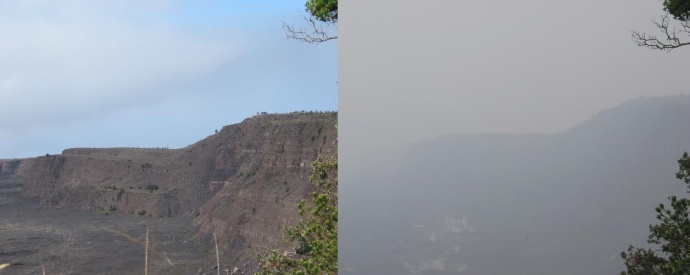New Study Looks at How People Cope with Vog

The rim of Kīlauea Volcano’s summit caldera, normally clear on trade-wind days (left), became nearly obscured by vog (right) on some non-trade wind days beginning in 2008, when sulfur dioxide emissions from the volcano’s summit increased to unusually high levels. USGS photos.
By Maui Now Staff
A new study to examine how people who live downwind of Hawaiʻi Island’s Kīlauea Volcano cope with volcanic gas emissions, or vog, is currently underway, according to new information released today by the Hawaiian Volcano Observatory.
The study, led by Dr. Claire Horwell, investigates how Hawaiʻi communities use advice offered by the state Department of Health and the American Lung Association, and if they have developed their own strategies for protecting themselves from vog.
Horwell, who is the Director of the International Volcanic Health Hazard Network, released a statement saying, “We’re working with State and county agencies with the end goal of providing consistent online advice, an informative pamphlet on vog exposure and protection, and updated guidance on how to access resources about vog.”
The HVO notes that sulfur dioxide from Kīlauea, now in its 33rd year of nearly continuous eruption, results in vog that continues to challenge communities, agriculture and infrastructure on the Island of Hawai‘i, as well as across the State.
The agency reports that communities downwind from Kīlauea’s active vents frequently experience vog as a visible haze or as a sulfurous smell or taste. Individuals exposed to vog often report a variety of symptoms, including coughing, wheezing, sore throats, and headaches.
Agency officials describe vog as the pollution formed from acidic gases and particles released by active volcanoes. It is reportedly composed primarily of sulfur dioxide gas and its oxidation products, such as sulfate aerosol.
The study is being conducted in cooperation with the US Geological Survey’s Hawaiian Volcano Observatory.
Dr. Horwell is currently meeting with community and agency focus groups on Hawai’i Island, and in the coming weeks, will conduct surveys in a number of communities regularly affected by vog, including Volcano, Pāhala, Ocean View and South Kona.










